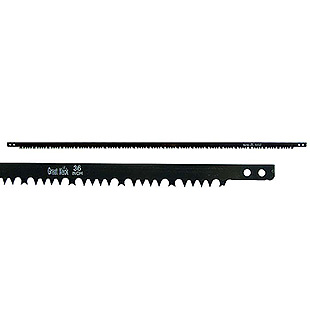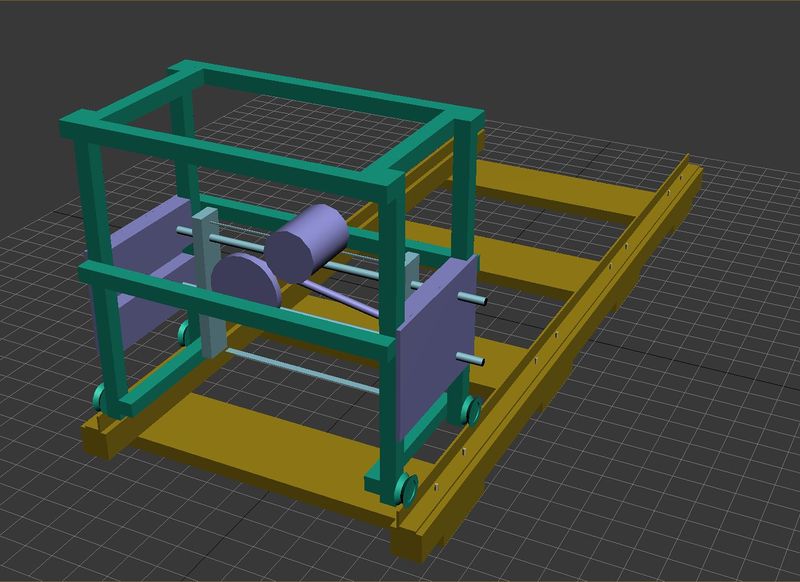Micro Sawmill
This is a design for a simple, low cost sawmill suitable for small village projects. It is a low production design. For high production, see Sawmill.
- Description
The basic concept is to hold a bow saw blade in tension horizontally, and mechanize the horizontal motion to saw. All the parts are reasonably off-the-shelf. Dimensions are variable to suit individual needs. The 3D model below omits some of the parts for clarity, and has a 10cm grid for this example version. When actually building, add bracing as needed to make the whole machine rigid enough to guide the blade in a straight line. The main parts are color coded in the model.
Bed - (yellow) The bed consists of cross ties fastened to rail supports and rails by carriage bolts. The cross ties and rail support are dimensional lumber, and the rails are metal angle iron. The log will rest on the cross ties. The rails need to be longer than the log you want to cut so the sawing head can clear both ends. The bed should be leveled for use.
Support Frame - (green) The support frame is made of dimensional lumber braced with plywood sheet or diagonals (not shown). It forms an arch which will clear the log, and rolls on V-groove wheels on the rails. Width between the wheels needs to be around twice the log diameter. A ruler should be attached somewhere on the frame to know what height you are cutting at.
Slide Mount - (purple) The slide mount allows height adjustment of the blade, and for the saw frame to move crosswise when the mill is running. It uses dimensional lumber and plywood. Cross members are omitted for clarity, but the left and right sides need to be attached so the mount moves up and down as a unit. The plywood on either side keep the mount aligned to the support frame. Some method to adjust and lock the height is needed. This can be clamps, or rope/cable from above with a crank system.
A moderate power, low RPM electric motor (such as a ceiling fan motor) is attached to the slide mount, and supplies power for the mill. It is geared down to a larger wheel. A bicycle gear and roller chain will work for this. The larger wheel drives a connector rod which pushes the saw frame sideways. The wheel should be weighted so it is in balance. The mount has holes with low friction sleeves (PVC tubing) to allow the saw frame slides to move freely.
Saw Frame (light blue) The saw frame has two slides (electrical conduit) and upright framing (dimensional lumber). The lower slide is bolted through to make a pivot. The upper slide merely goes through a hole in the uprights. A threaded rod or chain at the top is used to provide tension for the blade. Metal angles are fastened to the inside bottoms of the uprights, and the blade is bolted horizontally to the angles.
- Operation
- Clamp log to bed so it does not move.
- Adjust blade height to near top of log.
- Start motor and push support frame steadily forward to cut log.
- Invert log and reset height to near top of log again, and nearest unit on the ruler, make second cut.
- Rotate log 1/4 turn, and clamp supports to hold it's rotation. Make third cut.
- Invert log and make fourth cut. This leaves a squared log.
- Use scale to adjust height by whatever board thickness you want and keep cutting boards.
You can rig a cable and falling weight system pull the support frame automatically. Cutting speed will mostly depend on the motor power.
Alternate Concept
See photos at [1]
This is basically a bandsaw mounted horizontally, with a support frame and rollers to guide it horizontally. It minimizes hardware required, and the need to lift/move the log from where felled.

